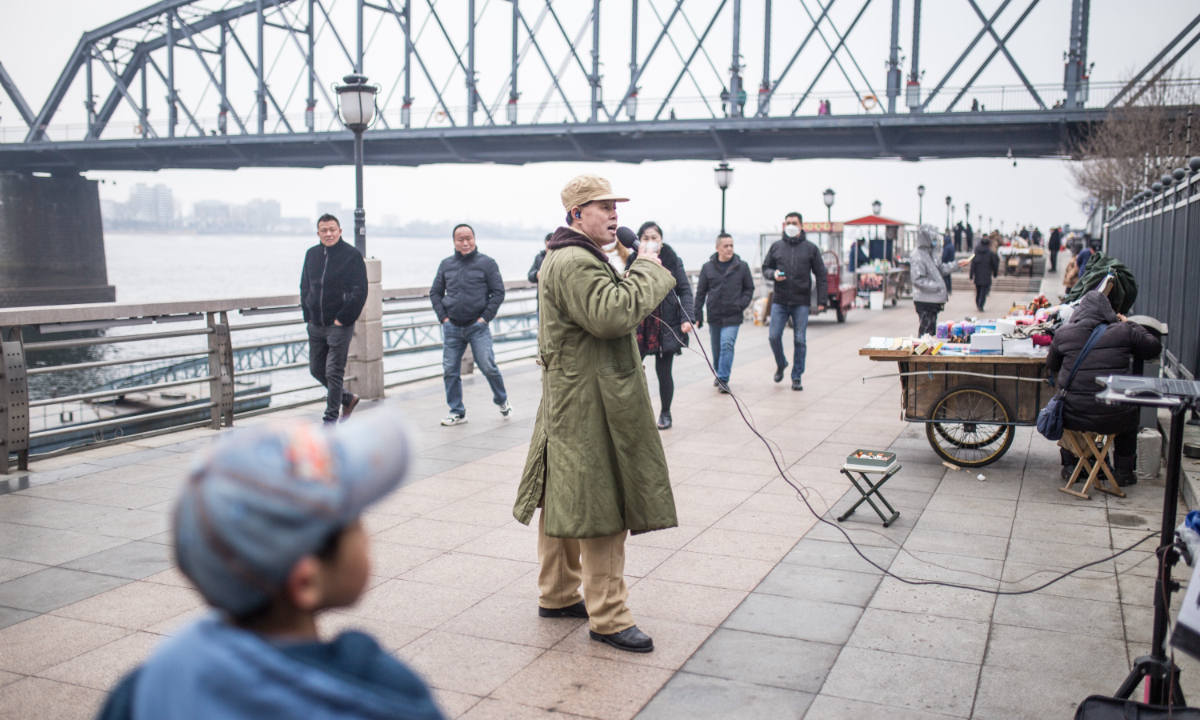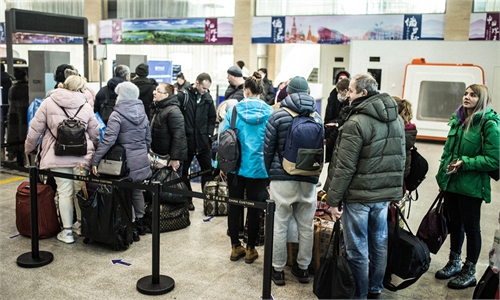GT on the spot: Border regions in ‘rusted’ northeast China explore new breakthroughs in process of Chinese-style modernization, rural revitalization
New solutions
As China emerges from the haze of the COVID-19 epidemic, many border regions in the Northeast have taken actions for economic and social revival and seen results, which might also serve as a new impetus in the revitalization of the entire Northeastern region of China during the process of modernization and rural constructions.
Decades ago, the Northeast region, consisting of Liaoning, Jilin, and Heilongjiang provinces, played a significant role as an old industrial base in the development and construction of the new China, but it gradually declined when China's economy really took off thanks to continued reform and opening up.

In recent years, this region has faced problems such as resource depletion and brain drain, and its glory days seem to be behind it. How to revitalize Northeast China has always been a topic of concern to the central government.
In April 2016, the central government rolled out new measures to revitalize the region struggling with industrial decline, falling investment, and a daunting business environment. As reforms are carried out, with a series of supporting policies released, a free trade zone has been set up in Liaoning, administrations have been streamlined, and the business environment improved, the Xinhua News Agency reported.
But some new-rising stars in the region might have been looking for new solutions. In an effort to foster new growth engines, the region is endeavoring to promote innovation-based development while adopting a global vision for reinvigorating the economy.
After recently visiting a number of port cities in the Northeast, the Global Times reporters found that border areas have been relying on their own locational advantages to explore new paths in the revitalization of the region.
Sectors such as border trade, tourism, and processing have become development highlights, and are expected to play a greater role in the process of Chinese-style modernization and rural revitalization.
Cross-border e-commerce
In Heihe, Northeast China's Heilongjiang Province on the China-Russian border, the cross-border e-commerce and livestreaming industries are booming, providing locals with new job opportunities.
In 2022, the total transactions of the cross-border e-commerce industrial park in Heihe, a border city between China and Russia in Northeast China's Heilongjiang Province, exceeded 1 billion yuan, with online retail sales reaching 323 million yuan, according to local authorities.
About 6 million orders had been made on the cross-border trade livestreaming platform belonging to the Heihe cross-border e-commerce industrial park in 2022 alone, with the aggregate sales value hitting 180 million yuan, Heihe authorities confirmed.
The outbreak of COVID-19 in early 2020 inspired many small and medium-sized e-commerce companies in the park to turn to livestreaming as a new sales channel, so that people could have the opportunity to build a cross-border e-commerce livesteaming base, Zhan Yucheng, deputy director of the foreign trade and cooperation center of the Heihe free trade zone, told the Global Times.
The base has attracted about 30 companies and 130 hosts. Yearly sales amount to the base reached a total of 150 million yuan in the last three years, according to Zhan.
Zhang Jian, a host working at the Heihe livestreaming base, told the Global Times that sales from his live stream sessions totaled 6 million yuan in 2022 and are expected to exceeded 7 million yuan in 2023, following the government's optimization of COVID-19 management in December 2022.
The best-selling goods during Zhang's livestreaming sessions are sweets and milk powder from Russia and Belarus, according to local media reports.
Song Xiaotao, chairman of Heihe Liyuanda Special Automobile Manufacturing Co, Ltd. told the media that during the hardest period, the Internet increased our sales volume and categories. Online business accounted for over 80 percent of the total and the company managed to expand our market from the Russian Far East to greater Europe.
The entrepreneur says the company now faces new challenges, including peer competition and the fast-changing global business environment. But it's getting support from local authorities including infrastructure, consulting services, and subsidies for logistics, he said.

Valueless cultures
The Northeast region has been a place where many ethnic groups have lived together since ancient times, and is also influenced by the cultures of neighboring countries. Today, these unique multicultural factors have been inherited, preserved, and developed, and have become precious resources in the region, which can play a role in future development.
The Yanbian Korean autonomous prefecture in Northeast China's Jilin is home to a large population of ethnic Koreans and has a distinct Korean influence in its culture, cuisine, and architecture. Now it is a great place for tourists who are interested in experiencing the culture and history of the Korean people.
Yanji, the capital city of Yanbian prefecture, has become one of the most popular travel destinations in China as the country downgraded its COVID management.
During the Spring Festival in 2023, Yanji, with a local population of about 600,000, received a total of 890,000 tourists, a year-on-year increase of 195.7 percent, and realized tourism revenue of 1.48 billion yuan, a year-on-year increase of 270 percent, the local publicity department told the Global Times.
Since 2022, the Yanbian area has been promoting its own cultural tourism resources according to its own formulated plan. Concerned parties invited internet influencers to promote its attractions while targeting potential groups, the Global Times learned.
The government has also done a good job in service guarantee after the number of tourist increases. The region also plans to launch a series of activities to attract tourists to drive rapid economic development.


In the Korean Folk Village in the suburbs of Yanji, visitors wearing traditional Korean ethnic costumes, who are jokingly called "escaping princesses or princes," posed in front of local traditional cottages.
This village is a recreation of a traditional village by local Korean ethnic people and is home to several cultural activities, including traditional Korean dance performances, handicrafts, and Korean-style barbecue.
Even the local daily morning market is thronged by tourists, weaving among the hawkers selling rice cakes, strawberries, or various kimchee creations.
Moreover, aside from ethnic Korean culture, the other calling card of Yanji is dinosaurs. The first dinosaur museum in Jilin was opened in 2022 in Yanji, where dinosaur remains were uncovered.
Covering an area of 40,000 square meters, the museum displays various items including dinosaur skeletons and fossils of dinosaur shoulder blades, and thigh and femur bones.
In May 2016, Chinese archaeologists discovered dinosaur fossils in many sites on Longshan Mountain in Yanji in the Korean Autonomous Prefecture of Yanbian. Ever since then, researchers have launched a large-scale excavation of dinosaur fossils in the city, discovering dozens of fossil sites and unearthing various fossils belonging to carnivorous dinosaurs, sauropods, iguanodons, etc., the Global Times learned.
New fashion of tourism
Dandong, a border city in Liaoning neighboring North Korea and an iconic site for the War to Resist US Aggression and Aid Korea (1950-53), has been actively making use of its own geographical and resource advantages to develop tourism.
Before the epidemic, the city was the most preferred and the largest port for Chinese tourists to North Korea. The number of tourists going to North Korea via Dandong port accounts for more than 80 percent of the total number of people going to North Korea, the Global Times learned from local authorities.
Along with the resumption of cross-border trade and the shift of COVID-19 management, Dandong is witnessing a revival of tourism.

Tourists climbed the Yalu River Broken Bridge, a symbol of the China-North Korean friendship, to learn about the history of heroism seven decades ago. Many tourists also took a cruise to appreciate the scenery along the river.
Local tour guides told the Global Times that the volume of tourists in Dandong has almost recovered to the same level it had been before the epidemic. "Particularly during the Spring Festival holidays, there were many tourists," a guide said.
However, tourists entering North Korea from Dandong have yet to return to normal.
Tourists were also keen to purchase goods from North Korea. Goat milk soup, dried seafood, and stamps from North Korea are among the most popular souvenirs for tourists in Dandong.
Birdwatchers also flock to Dandong every spring to catch the natural spectacle of flocks of wild birds circling over the high tide to find food.
The coastal wetland of the Yalu River is a national reserve founded in 1987. The 108,100-hectare reserve is home to 215,700 wild birds from 70 species, according to media reports.
The improved environment of the river basin has attracted more birds to forage and thrive. International ornithologists who have traced the migrating birds arriving in the Yalu River area during the spring have found that many birds migrate from Australia, New Zealand, the Republic of Korea, and Thailand.
Farmers growing strawberries, another golden business card for the harbor city, are also benefiting from bird-watching tourism.
Some strawberry farmers had been working with local tour agencies to help develop tourist itineraries combining bird-watching sites and fruit-picking activities in local orchards.
The humid climate along the river and coast, the best strawberry production zone at 40 degrees north latitude, and the unique soil provide a high-quality growth environment for Dandong Donggang strawberries.
According to media reports, there are more than 100,000 farmers in Donggang engaged in strawberry production, and the annual per capita strawberry income accounts for more than 60 percent of the total income of farmers. In 2022, the planting area of Donggang Strawberry covered an area of 201,000 mu, with an annual output of 316,000 tons and a fresh fruit output value of 6.3 billion yuan.
Decades ago, the Northeast region, consisting of Liaoning, Jilin, and Heilongjiang provinces, played a significant role as an old industrial base in the development and construction of the new China, but it gradually declined when China's economy really took off thanks to continued reform and opening up.

Heihe, Northeast China's Heilongjiang Province on the China-Russian border Photo: Shan Jie/GT
In recent years, this region has faced problems such as resource depletion and brain drain, and its glory days seem to be behind it. How to revitalize Northeast China has always been a topic of concern to the central government.
In April 2016, the central government rolled out new measures to revitalize the region struggling with industrial decline, falling investment, and a daunting business environment. As reforms are carried out, with a series of supporting policies released, a free trade zone has been set up in Liaoning, administrations have been streamlined, and the business environment improved, the Xinhua News Agency reported.
But some new-rising stars in the region might have been looking for new solutions. In an effort to foster new growth engines, the region is endeavoring to promote innovation-based development while adopting a global vision for reinvigorating the economy.
After recently visiting a number of port cities in the Northeast, the Global Times reporters found that border areas have been relying on their own locational advantages to explore new paths in the revitalization of the region.
Sectors such as border trade, tourism, and processing have become development highlights, and are expected to play a greater role in the process of Chinese-style modernization and rural revitalization.
Cross-border e-commerce
In Heihe, Northeast China's Heilongjiang Province on the China-Russian border, the cross-border e-commerce and livestreaming industries are booming, providing locals with new job opportunities.
In 2022, the total transactions of the cross-border e-commerce industrial park in Heihe, a border city between China and Russia in Northeast China's Heilongjiang Province, exceeded 1 billion yuan, with online retail sales reaching 323 million yuan, according to local authorities.
About 6 million orders had been made on the cross-border trade livestreaming platform belonging to the Heihe cross-border e-commerce industrial park in 2022 alone, with the aggregate sales value hitting 180 million yuan, Heihe authorities confirmed.
The outbreak of COVID-19 in early 2020 inspired many small and medium-sized e-commerce companies in the park to turn to livestreaming as a new sales channel, so that people could have the opportunity to build a cross-border e-commerce livesteaming base, Zhan Yucheng, deputy director of the foreign trade and cooperation center of the Heihe free trade zone, told the Global Times.
The base has attracted about 30 companies and 130 hosts. Yearly sales amount to the base reached a total of 150 million yuan in the last three years, according to Zhan.
Zhang Jian, a host working at the Heihe livestreaming base, told the Global Times that sales from his live stream sessions totaled 6 million yuan in 2022 and are expected to exceeded 7 million yuan in 2023, following the government's optimization of COVID-19 management in December 2022.
The best-selling goods during Zhang's livestreaming sessions are sweets and milk powder from Russia and Belarus, according to local media reports.
Song Xiaotao, chairman of Heihe Liyuanda Special Automobile Manufacturing Co, Ltd. told the media that during the hardest period, the Internet increased our sales volume and categories. Online business accounted for over 80 percent of the total and the company managed to expand our market from the Russian Far East to greater Europe.
The entrepreneur says the company now faces new challenges, including peer competition and the fast-changing global business environment. But it's getting support from local authorities including infrastructure, consulting services, and subsidies for logistics, he said.

A woman hosts a livestreaming session in the Heihe cross-border e-commerce livesteaming base. Photo: Shan Jie/GT
Valueless cultures
The Northeast region has been a place where many ethnic groups have lived together since ancient times, and is also influenced by the cultures of neighboring countries. Today, these unique multicultural factors have been inherited, preserved, and developed, and have become precious resources in the region, which can play a role in future development.
The Yanbian Korean autonomous prefecture in Northeast China's Jilin is home to a large population of ethnic Koreans and has a distinct Korean influence in its culture, cuisine, and architecture. Now it is a great place for tourists who are interested in experiencing the culture and history of the Korean people.
Yanji, the capital city of Yanbian prefecture, has become one of the most popular travel destinations in China as the country downgraded its COVID management.
During the Spring Festival in 2023, Yanji, with a local population of about 600,000, received a total of 890,000 tourists, a year-on-year increase of 195.7 percent, and realized tourism revenue of 1.48 billion yuan, a year-on-year increase of 270 percent, the local publicity department told the Global Times.
Since 2022, the Yanbian area has been promoting its own cultural tourism resources according to its own formulated plan. Concerned parties invited internet influencers to promote its attractions while targeting potential groups, the Global Times learned.
The government has also done a good job in service guarantee after the number of tourist increases. The region also plans to launch a series of activities to attract tourists to drive rapid economic development.

Tourists visit attractions in Yanji, Northeast China's Jilin Province. Photo: Shan Jie/GT

Tourists visit attractions in Yanji, Northeast China's Jilin Province. Photo: Shan Jie/GT
In the Korean Folk Village in the suburbs of Yanji, visitors wearing traditional Korean ethnic costumes, who are jokingly called "escaping princesses or princes," posed in front of local traditional cottages.
This village is a recreation of a traditional village by local Korean ethnic people and is home to several cultural activities, including traditional Korean dance performances, handicrafts, and Korean-style barbecue.
Even the local daily morning market is thronged by tourists, weaving among the hawkers selling rice cakes, strawberries, or various kimchee creations.
Moreover, aside from ethnic Korean culture, the other calling card of Yanji is dinosaurs. The first dinosaur museum in Jilin was opened in 2022 in Yanji, where dinosaur remains were uncovered.
Covering an area of 40,000 square meters, the museum displays various items including dinosaur skeletons and fossils of dinosaur shoulder blades, and thigh and femur bones.
In May 2016, Chinese archaeologists discovered dinosaur fossils in many sites on Longshan Mountain in Yanji in the Korean Autonomous Prefecture of Yanbian. Ever since then, researchers have launched a large-scale excavation of dinosaur fossils in the city, discovering dozens of fossil sites and unearthing various fossils belonging to carnivorous dinosaurs, sauropods, iguanodons, etc., the Global Times learned.
New fashion of tourism
Dandong, a border city in Liaoning neighboring North Korea and an iconic site for the War to Resist US Aggression and Aid Korea (1950-53), has been actively making use of its own geographical and resource advantages to develop tourism.
Before the epidemic, the city was the most preferred and the largest port for Chinese tourists to North Korea. The number of tourists going to North Korea via Dandong port accounts for more than 80 percent of the total number of people going to North Korea, the Global Times learned from local authorities.
Along with the resumption of cross-border trade and the shift of COVID-19 management, Dandong is witnessing a revival of tourism.

Dandong, Northeast China's Liaoning Province on February 17, 2023 Photo: Shan Jie/GT
Tourists climbed the Yalu River Broken Bridge, a symbol of the China-North Korean friendship, to learn about the history of heroism seven decades ago. Many tourists also took a cruise to appreciate the scenery along the river.
Local tour guides told the Global Times that the volume of tourists in Dandong has almost recovered to the same level it had been before the epidemic. "Particularly during the Spring Festival holidays, there were many tourists," a guide said.
However, tourists entering North Korea from Dandong have yet to return to normal.
Tourists were also keen to purchase goods from North Korea. Goat milk soup, dried seafood, and stamps from North Korea are among the most popular souvenirs for tourists in Dandong.
Birdwatchers also flock to Dandong every spring to catch the natural spectacle of flocks of wild birds circling over the high tide to find food.
The coastal wetland of the Yalu River is a national reserve founded in 1987. The 108,100-hectare reserve is home to 215,700 wild birds from 70 species, according to media reports.
The improved environment of the river basin has attracted more birds to forage and thrive. International ornithologists who have traced the migrating birds arriving in the Yalu River area during the spring have found that many birds migrate from Australia, New Zealand, the Republic of Korea, and Thailand.
Farmers growing strawberries, another golden business card for the harbor city, are also benefiting from bird-watching tourism.
Some strawberry farmers had been working with local tour agencies to help develop tourist itineraries combining bird-watching sites and fruit-picking activities in local orchards.
The humid climate along the river and coast, the best strawberry production zone at 40 degrees north latitude, and the unique soil provide a high-quality growth environment for Dandong Donggang strawberries.
According to media reports, there are more than 100,000 farmers in Donggang engaged in strawberry production, and the annual per capita strawberry income accounts for more than 60 percent of the total income of farmers. In 2022, the planting area of Donggang Strawberry covered an area of 201,000 mu, with an annual output of 316,000 tons and a fresh fruit output value of 6.3 billion yuan.



